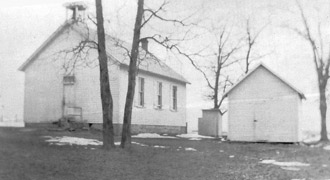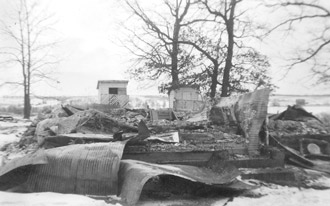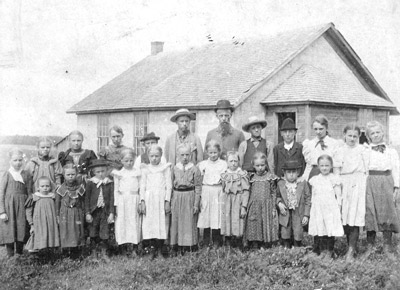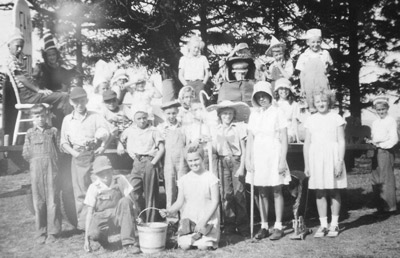![]()
Fan School Makee twp. |

The Old Fan School
The school building pictured above was built in 1899 on an original plot of land in what was called the Fan Independent School District in Makee Township of Allamakee County. The school building later burned to the ground in 1952, but students and teachers from the school are working on a reunion for June 24, 2006.

The Fan School constructed in 1899 burned to the ground December
13, 1952
The Fan School
by Maury Gallagher
One room country schools were the source of early education for many generations of Iowa’s children who lived in rural areas of the state. From the establishment of the first school in Lee County in 1830, the number of rural schools in Iowa swelled to over 12,600 by 1901. By 1960, most had closed, and students traveled by bus to consolidated schools in town.
The shared experiences of attending country school, so long ago, still live on in the memories of those students who now live lives far removed from those earlier days. But the desire to reminisce and enjoy the company of those old friends and neighbors has not diminished.
With that in mind, some former students of the Fan School in Allamakee County are planning a reunion for former students, teachers and their families. The reunion will be held at the Sweeney shelter in the Waukon City Park from 12 to 4 p.m. June 24 this year.
Iowa became a state in 1846. Twelve years later, in 1858, Iowa established the county township as the responsible entity for the establishment of independent schools. In 1868, the Fan Independent School District in Makee Township of Allamakee County purchased a half-acre of land from Herman and Louisa Klama for the purpose of building a school.
“Where the name ‘Fan’ came from is a mystery,” former Fan School student Jim Moe said. “The initial site was in the geographic center of the Fan District, so no student would have to travel more than two miles to school. It was also one of the highest points in Allamakee County. You have heard the stories about students having to walk for miles to get to school and it was uphill both directions. Well, at the Fan School, everyone had to go uphill to get there. The trip home was downhill, though.”
No records have yet been found to indicate that a school was built on this original site, but it is presumed that one was indeed built there. In March of 1886, the great- great grandparents of Jim Moe, Hans and Margaret Johnson, deeded a half-acre of land nearby to the Fan School District. A small school was built on that land in 1886, and served the community until 1899.
In 1899, the Fan School District contracted with G. A. Hansmeier for the construction of a new school on the original half-acre of land that had been purchased from the Klama’s. The school was built that year at a cost of $544.50. It was a 24’ x 36’ structure that was 12’ high. This school, complete with both boys and girls outhouses, would serve the township students for 53 years.
December 13, 1952 the building burned to the ground, and students continued their education in Waukon schools. In 1953, the State of Iowa passed a law that formed Community School Districts which consolidated most of the one room school districts. The era of country schools came to an end within the next ten years.
Some of the old country schools have survived to serve as museums, storage sheds Some of the old country schools have survived to serve as museums, storage sheds and even family residences, but most have disappeared from the landscape. The memories remain for those who attended them. Jim Moe and Bill Steffenson attended Fan School, and Nona Hansmeier is one of four former Fan School teachers still living in the local area.
Jim attended Fan School from 1943 to 1946. Bill attended from 1945 to 1952. They remember that the school had no electricity until August of 1946. The school also did not have a well, so the students had to carry water, which they would get at various sites. There was a spring over the hill from the school. At the spring there was a pit laid up with rocks and the water was piped out to a tank.
“We got water from the spring, and also from Jim Moe’s and Hank Lonning's,” Bill said. “But the place I liked to go best was up to Hamman’s. The Hammans lived in the tarpaper shack south of the school, and Mrs. Hamman always had cookies for us when we went there.” Bill’s grandfather was one of the first directors of the Fan School. “The election for a director resulted in a tie vote, and my grandfather was elected when the tie was broken by drawing straws,” Bill said. “He drew the long straw.”
The “tarpaper shack,” a well known landmark east of Waukon, served as a guidepost for those looking for the Fan School. The directions were always to “Go east to the tarpaper shack and turn left. The school is a half mile north of the tarpaper shack.”
“Some country schools had pianos, but we were a poor school. We did have a phonograph, though,” Jim said. “Books were purchased in Waukon at the Carter and Herman, Opfer’s or Drew and Haas drugstores. You tried to get there early so you could get the used books. They were cheaper.”
School was held every scheduled day unless the teacher couldn’t get there. There was no telephone in the schoolhouse, but one long ring on the telephone, known as a general ring, would let families know that there would be no school that day. The general ring was also a signal for emergencies in the area. The signal at the school for an emergency, in the absence of a telephone, was to fly the flag upside down.
School was in session for nine months each year, with a six-week kindergarten each spring. Students raised the flag every morning. The school day began with the Pledge of Allegiance. Grades one through eight all were taught in the single classroom. Subjects included arithmetic, reading, spelling, phonics, penmanship, history, art, language, geography and deportment.
Recess allowed time for playing ball, and games like “ante over” the schoolhouse. In the winter, recess allowed just enough time for only one half-mile sled ride down the hill, and the walk back. In the spring and fall, lunches were packed for long hikes. During World War II, the classes would work together to collect milkweed pods used to make life preservers for pilots and sailors.
Nona Hansmeier taught at the Fan School from 1944 to 1945 and again from 1948 to 1949. When she graduated from Waukon High School she had completed the State mandated “Normal Training” that qualified her to teach school. College education was not required at that time. “After three years of Normal Training under Cora Rueggenmeier,” Nona said, “you were ready to teach.” Nona also taught at the Red School and Jefferson # 4. She left teaching for fifteen years to raise her family, and returned to teach fourth grade in Waukon from 1968 to 1990. Nona graduated from Upper Iowa University with a B. A. after many years of night school and summer school. She continues to work as a substitute teacher. Other Fan School teachers still in the area include Lorraine Hansmeier, Carol Hanson, and Christine (Sorum) Bruvold.
“In country school,” Nona said, “class periods were only eight to 10 minutes. Each class would come to the recitation bench at the front of the classroom. There was never much homework assigned. The parents were involved and there were no distractions at home like television. The younger students also learned through the older kids' classes. There was more respect for teachers and authority figures back then.”
While Nona was at the Fan School, the school had what was likely one of the first “hot lunch” programs in country school. "One day each week,” she noted, “one parent would bring something hot for the students' lunch.” School supplies were a problem for teachers in country school, just as they often are today. “Once a year we would have a box lunch social to raise money for supplies such as construction paper, etc. The children would put on one-act plays and the decorated box lunches would be auctioned off.”
In 1904, Fan School had 39 students. Some transferred to another district to help that district have enough students to keep their school open. In 1952, when the school burned, 26 students were enrolled there. “When the school burned,” Bill Steffenson noted, “we had a long Christmas vacation before we started school in Waukon. One thing still bothers me about that fire. I had a cigar box full of baseball cards at the school. They all burned up.”
Oh, the memories!!

Fan School & schoolchildren, undated photo

Fan School - undated photo, caption: School Float
Can you identify anyone in these photos or date them? Please notify the Allamakee co. coordinator.
~*~*~
The above article & photos were originally published in a May 2006 issue of the Waukon Standard
Permission to re-publish on the Allamakee co. IAGenWeb website was generously granted by the author Maury Gallagher, and by Jeremy J. Troendle Managing Editor, Waukon Newspapers. Thank-you!!